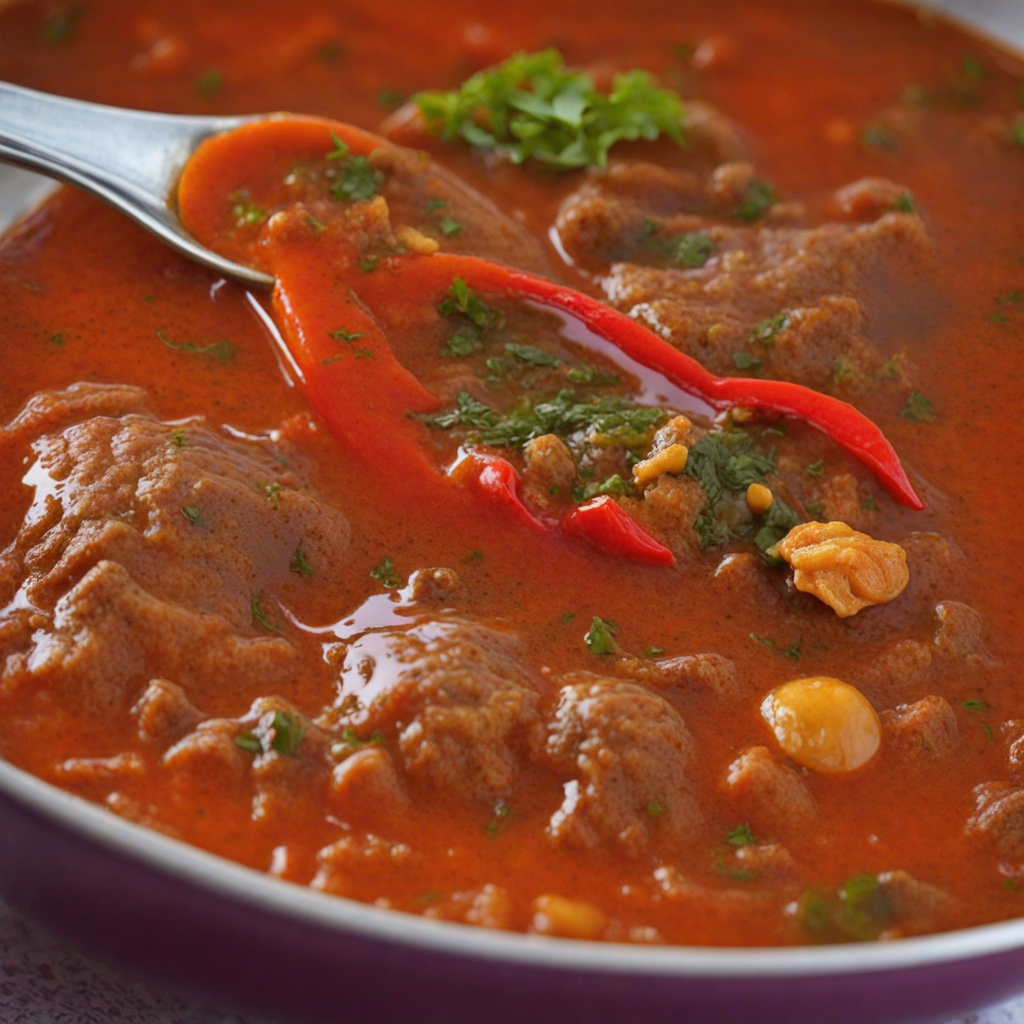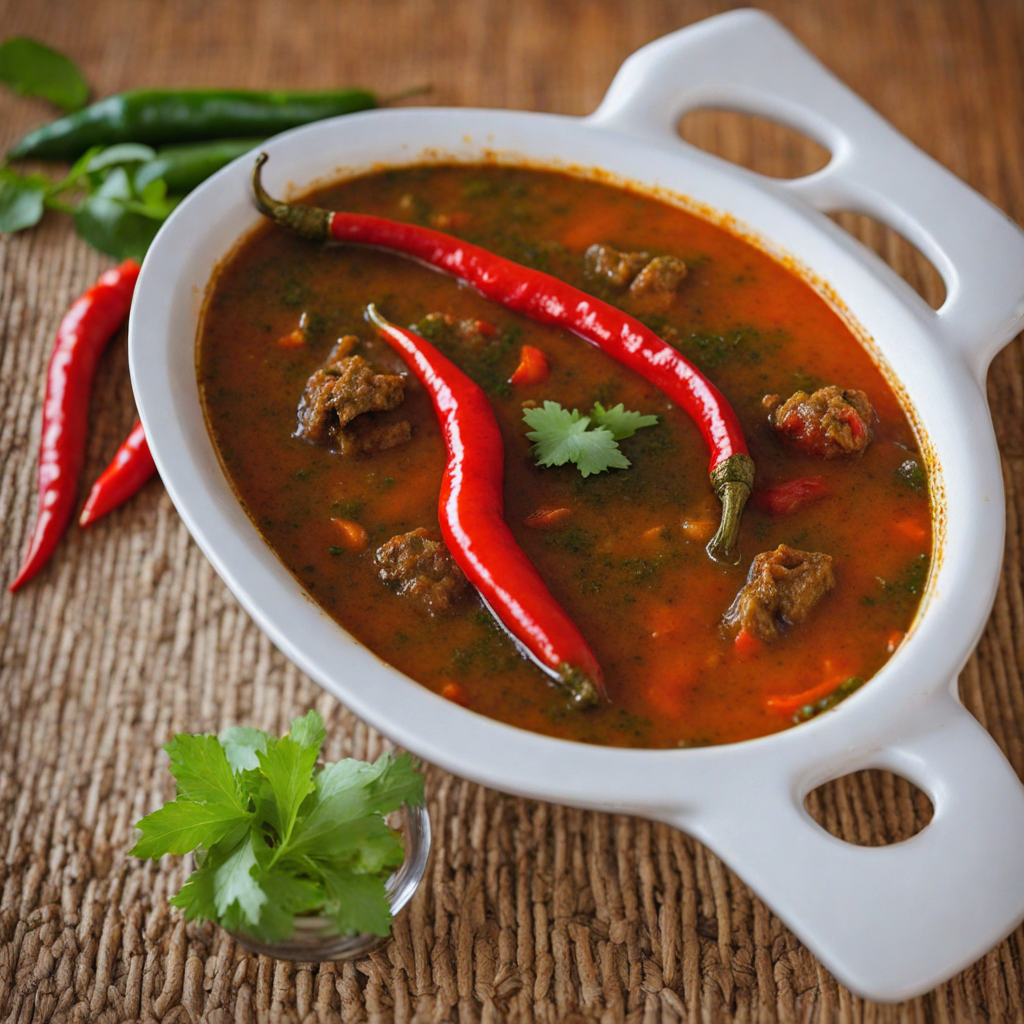Hot Pepper Soup
Hot Pepper Soup is a vibrant and aromatic dish hailing from Ghana, known for its bold flavors and invigorating heat. This soup is primarily made with a rich blend of spices, fresh peppers, and a protein base, often featuring chicken, fish, or goat meat. The intense heat of the peppers is balanced by the savory undertones of onions, garlic, and ginger, creating a complex flavor profile that tantalizes the taste buds. The careful combination of ingredients results in a broth that is both soothing and invigorating, making it a popular choice for those seeking comfort food with a kick. What truly sets Hot Pepper Soup apart is the use of local Ghanaian spices, such as ground crayfish and traditional herbs, which infuse the dish with an authentic taste of the region. The vibrant red color of the soup, derived from the peppers and spices, is visually striking and inviting. As you take your first sip, the warmth envelops you, and the rich, spicy aroma fills the air, awakening your senses and preparing you for a culinary adventure. This soup is often enjoyed as a starter or main dish and is commonly served with rice or fufu, a starchy side made from cassava or plantains. The combination of the hearty soup and the accompanying starch creates a satisfying and fulfilling meal. Whether enjoyed on a chilly day or as a remedy for a cold, Hot Pepper Soup is not just a dish; it's an experience that captures the essence of Ghanaian cuisine, inviting you to explore its rich culinary heritage.
How It Became This Dish
The History and Significance of Shito in Ghana #### Origins Shito is a quintessential Ghanaian condiment known for its rich, spicy flavor and deep cultural roots. The name “Shito” comes from the Ga word for pepper, reflecting its primary ingredient: a potent blend of dried fish, ground pepper, and a variety of spices. This beloved sauce is integral to the Ghanaian culinary landscape, transcending its role as just a condiment to become a symbol of regional pride and cultural identity. The origins of Shito can be traced back to the coastal regions of Ghana, where fishing communities relied heavily on the ocean's bounty. The use of dried fish as a primary ingredient is indicative of the traditional preservation methods employed by these communities. Fish, particularly anchovies and sardines, were sun-dried and used to enhance flavors in various dishes. Over time, these fishing communities began to incorporate spices and peppers into their recipes, giving birth to what we now know as Shito. #### Cultural Significance Shito is much more than a mere condiment; it is a staple in many Ghanaian households and is often referred to as the "soul" of Ghanaian cuisine. Its significance lies not only in its flavor but also in its ability to bring people together. Shito is commonly served with a wide array of dishes, from jollof rice to fried yam, and is a key component of meals during family gatherings, celebrations, and communal feasts. In Ghanaian culture, food plays a critical role in social interactions. Sharing a meal accompanied by Shito fosters a sense of community and belonging. It is often said that a meal without Shito is incomplete, highlighting its importance in the Ghanaian dining experience. The condiment is also a source of pride for many Ghanaians, with families often passing down their unique recipes through generations, each adding their own twist to the traditional preparation. Moreover, Shito holds economic significance. Many women in Ghana have turned the production of Shito into a thriving business, creating small-scale enterprises that contribute to their households and communities. Marketplaces in cities like Accra are lined with vendors selling homemade Shito, each claiming their version is the best. This entrepreneurial spirit has not only helped elevate the status of Shito but has also empowered women and provided them with a source of income. #### Development Over Time As Ghana has evolved, so too has the preparation and consumption of Shito. Initially, Shito was a simple blend of dried fish, pepper, and palm oil. However, with the passage of time, the recipe has undergone numerous adaptations and innovations, influenced by globalization, migration, and the availability of new ingredients. In the late 20th century, as the Ghanaian diaspora spread across the globe, so did the love for Shito. Ghanaians living abroad began to recreate their favorite foods, often sourcing spices and ingredients from local markets. This led to the introduction of new flavors and variations of Shito, incorporating elements from other culinary traditions. For instance, some recipes began to include additional ingredients like garlic, ginger, or even tomatoes, creating a more complex flavor profile that appealed to a broader audience. The rise of social media and food blogging in the 21st century has also played a pivotal role in the popularization of Shito. As Ghanaians (and food enthusiasts) share their cooking experiences online, Shito has gained recognition beyond the borders of Ghana. It has caught the attention of chefs and food lovers worldwide, leading to its integration into fusion cuisine and contemporary menus. Restaurants specializing in Ghanaian cuisine have embraced Shito, introducing it to new audiences and pairing it with diverse dishes. This has not only increased its visibility but has also contributed to a growing appreciation for Ghanaian culinary traditions on a global scale. #### Shito Today Today, Shito is celebrated both at home and abroad. It remains a staple in Ghanaian kitchens, with families preparing large batches to last for weeks. The condiment is often served in small bowls alongside meals, allowing diners to enjoy as much or as little as they desire. In recent years, there has been a renewed interest in traditional foods and artisanal products, with many Ghanaians seeking out locally made Shito that reflects authentic flavors and techniques. This has led to a resurgence in traditional cooking methods, with some producers opting for time-honored recipes that prioritize quality and authenticity over mass production. Shito is also finding its way into modern culinary innovations. Chefs are experimenting with it in various dishes, using it as a marinade for meats, a topping for pizzas, and even as a flavor enhancer in soups and stews. The versatility of Shito has allowed it to transcend its traditional boundaries, appealing to a diverse range of palates and culinary preferences. #### Conclusion Shito is more than just a condiment; it is a culinary emblem of Ghana's rich history, cultural significance, and adaptability. As it continues to evolve, Shito remains a vital part of Ghanaian identity, connecting generations through shared recipes and memories. The journey of Shito, from humble fishing communities to global culinary recognition, reflects the resilience and creativity of the Ghanaian people and their unwavering love for their culinary heritage. As we savor the spicy, umami-rich flavors of Shito today, we not only indulge in a delicious condiment but also partake in a vibrant cultural narrative that has shaped Ghanaian cuisine for centuries.
You may like
Discover local flavors from Ghana







